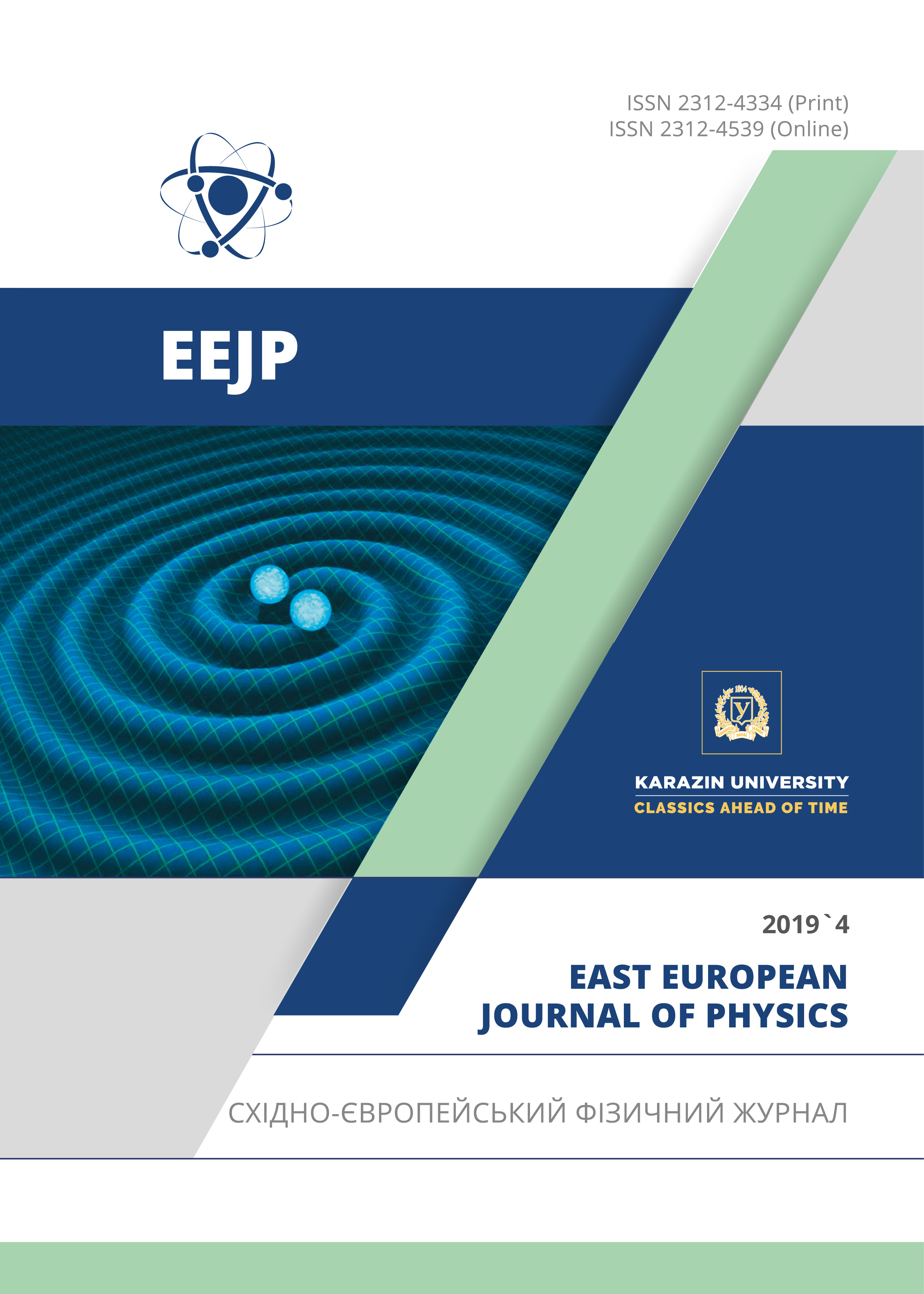Вплив осцилляцій електричного поля внаслідок осцилляцій електричного диполя на Раманівські лінії
Анотація
Ефект Рамана полягає у вимірюванні інтенсивності та довжини хвиль непружно розсіяного випромінювання, яке падає на молекулу. Електричне поле випромінювання поляризує молекулу, на яку вона падає, і це призводить до створення коливань диполя. Поляризоване лазерне світло, що падає, непружно розсіюється молекулярним зразком. Розсіяне світло містить змінені довжини хвиль, які називаються Стоксівськими та анти-Стоксівськими довжинами хвиль. Електричний диполь, що
коливається внаслідок падаючого випромінювання, створює навколо себе коливальне електричне поле. Оскільки коливальне електричне поле падаючого випромінювання створює коливальний електричний диполь, який створює навколо нього коливальне електричне поле, то вважається, що це коливальне електричне поле може впливати на частоту коливань або коливання електричного диполя, який його виробляє. Цей новий ефект змінить частоту (частоти) розсіяного випромінювання,
що призведе до появи ліній Стокса та анти-Стокса зі зміненими частотами. Це теоретичне дослідження та його значення можна пояснити наступним чином. Наприклад, якщо є дві клітини або молекули поруч, у яких одна є здоровою клітиною, а інша – раковою, або два різних типів молекул що знаходяться поряд, цей тип розсіювання повинен бути в змозі розрізнити одну ситуацію від іншої, оскільки лінії Стокса і анти-Стокса від двох молекул не будуть ідентичними. Таким чином падаюче
випромінювання кутової частоти ω1 поляризує молекулу, на яку вона падає, і це призводить до створення коливального диполя частоти ω2. Коливальний диполь створює коливальне електричне поле, яке може створити додаткову частоту коливального диполя, який його створив, і нехай це буде ωD. Тоді лінії Рамана можуть мати частоти (ω1+ω2+ωD), (ω1+ω2-ωD), (ω1-ω2+ωD) та (ω1-ω2-ωD). Залежно від відносних величин ω2 і ωD, лінії Рамана будуть позначатися як лінії Стокса і анти-Стокса. Через закон збереження енергії ωD буде менше ніж ω2, оскільки коливальний диполь не може створити поле частоти більше своєї власної частоти. Отже, частоти (ω1-ω2+ωD) і (ω1-ω2-ωD) відповідають лініям Стокса і частотам. (ω1+ω2+ωD) і (ω1+ω2-ωD) будуть відповідати лініям анти-Стокса. Розрахунки ліній Стокса та анти-Стокса були зроблені для деяких молекул: аміаку (NH3), оксиду азоту (N2O), води (H2O), діоксиду сірки (SO2), (O3). Розрахунки також були проведені для сполук, що містять вуглець, таких як дихлорметан (CH4Cl2), мурашиної кислоти (CH2O2), метанолу (CH4O), бензолу (C6H6), пропану (C3H8) та карбонілхлориду (Cl2CO). Розроблена теорія передбачає нові явища для отримання ліній Стокса та анти-Стокса зі зміненою довжиною хвилі, які не спостерігалися експериментально на сьогоднішній день.
Завантаження
Посилання
A. Smekal, Naturwiss, 11(43), 873-875(1923), https://doi.org/10.1007/BF01576902.
C.V. Raman andK.S. Krishnan,Nature, 121, 501-502 (1928), https://doi.org/10.1038/121501c0.
K.F. Kohlrauch, Der Smekal –Raman–Effect, (Springer, Berlin, 1931); Ergänzungsband 1931-1937, (Springer,1938).
E. Garcia-Rico, R.A. Alvarez-Puebla, L. Guerrini, Chem. Soc. Rev. 47, 4909-4923 (2018), https://doi.org/10.1039/C7CS00809K.
J.D. Jackson, Classical Electrodynamics, (Wiley, New York, 1975).
L.D. Landau and E.M. Lifshitz, Electrodynamics of Continuous Media, (Pergamon, 1971).
M. Born and E. Wolf, Principles of Optics, (Pergamon, 1970).
A.N. Laurence, Journal of Raman spectroscopy, 41, (2017), https://doi.org/10.1002/jrs.5310.
P. Rostron, S. Gaber and D. Gaber, IJETR, 6(1), 2454-4698 (2016), https://www.researchgate.net/profile/Paul_Rostron/publication/309179824_Raman_Spectroscopy_a_review/links/580329fe08ae23fd1b673f34/Raman-Spectroscopy-a-review.pdf.
B. Hruška, A.A. Osipov, L.M. Osipova, M. Chromčíková, J. Macháček and M. Liškaac, Vibrational Spectroscopy, 105, 102970 (2019), https://doi.org/10.1016/j.vibspec.2019.102970.
R.R. Jones, D.C. Hooper, Liwu Zhang, D. Wolverson and V.K. Valev, Nanoscale Res Lett. 14, 231 (2019), https://dx.doi.org/10.1186%2Fs11671-019-3039-2
R. Ravanshad, A.K. Zadeh, and A.M. Amani, Nano Reviews & Experiments, 9(1), 1373551 (2018), https://doi.org/10.1080/20022727.2017.1373551.
K.E. Sundling and A.C. Lowe, Advance Anat. Pathology, 26(1), 56-63 (2019), https://doi.org/10.1097/PAP.0000000000000217.
S. Devpura, K.N. Barton, S.L. Brown, O. Palyvoda, S. Kalkanis, V.M. Naik, F. Siddiqui, R. Naik and I.J. Chetty, International Journal of Medical Physics Research and Practice, 41(5), 050901 (2014), https://doi.org/10.1118/1.4870981
L. Guerrini and R.A. Alvarez-Puebla, Cancers, 11(6), 748 (2019), http://doi.org/10.3390/cancers11060748.
Non-Linear Raman spectroscopy and its chemical applications, Proceedings of the NATO Advanced Study Institute held at Bad Windsheim, Germany, edited by W. Kiefer and D.A. Long (D. Reidel Publishing Company, London, 1982), pp. 643.
A. Mohammed, H. Ågren and P. Norman, Chem. Phys. Lett. 468, 119-123 (2009), https://doi.org/10.1016/j.cplett.2008.11.063.
D.J. Griffiths, Introduction to Electrodynamics, 3rd edition,(Pearson Education, 2007).
D.R. Lide, editor, CRC Handbook of Chemistry and Physics, Internet Version 2005, (CRC Press, Boca Raton, 2005), http://www.hbcpnetbase.com.
H.J. Hibben, The Raman Effect and its Chemical Applications, (Reinhold Publishing Company, New York, 1939), https://doi.org/10.1002/ange.19400531511.
D.A. Long, The Raman Effect: A Unified Treatment of the Theory of Raman Scattering by Molecules, (Willey, England, 2002), pp. 624.
A. Mahadevan‐Jansen, M.F. Mitchell, N. Ramanujamf, A. Malpica, S. Thomsen, U. Utzinger and R. Richards‐Kortum, Photochemistry and Photobiology, 68(1), 123–132 (1998), https://doi.org/10.1111/j.1751-1097.1998.tb03262.x.
A. Mahadevan-Jansen, M.F. Mitchell, N. Ramanujam, U. Utzinger and R. Richards-Kortum, Photochemistry and Photobiology 68(3), 427–431 (1998), https://doi.org/10.1111/j.1751-1097.1998.tb09703.x.
P.R.T. Jess, D.D.W. Smith, M. Mazilu, K. Dholakia, A.C. Richesand and C.S. Herrington, International Journal of Cancer, 121(12), 2723–2728 (2007), https://doi.org/10.1002/ijc.23046.
J.L. González-Solís, C. Martínez-Espinosa, L.A. Torres-González, A. Aguilar-Lemarroy, L.F. Jave-Suárez and P. Palomares-Anda, Lasers in Medical Science, 29(3), 979–985 (2014), https://doi.org/10.1007/s10103-013-1447-6.
Yong Wang, Chia-Yu Lin, A. Nikolaenko, V. Raghunathan and E.O. Potma, Advances in Optics and Photonics, 3(1), 1-52 (2011), https://doi.org/10.1364/AOP.3.000001.
Ji-Xin Cheng and Xiaoliang Sunney Xie, Coherent Raman scattering microscopy, (CRCPress, Taylor&Francis group, 2013).
N. Buzgar, A.I. Apopei and A. Buzatu, (2009), Theory of Raman spectroscopy. Quantum and Classical Raman theory, http://www.rdrs.ro/blog/quantum-classical-raman-theory/.
Theory of Raman spectroscopy, (2019), https://chem.libretexts.org/Bookshelves/Analytical_Chemistry/Map%3A_Principles_of_Instrumental_Analysis_(Skoog_et_al.)/18%3A_Raman_Spectroscopy/18.1%3A_Theory_of_Raman_Spectroscopy.
E.S. Winesett, C.H. Londergan and L.K. Charkoudian, Nat. Commun. 10(1), 2227 (2019), https://doi.org/10.1038/s41467-019-10184-2.
Автори, які публікуються у цьому журналі, погоджуються з наступними умовами:
- Автори залишають за собою право на авторство своєї роботи та передають журналу право першої публікації цієї роботи на умовах ліцензії Creative Commons Attribution License, котра дозволяє іншим особам вільно розповсюджувати опубліковану роботу з обов'язковим посиланням на авторів оригінальної роботи та першу публікацію роботи у цьому журналі.
- Автори мають право укладати самостійні додаткові угоди щодо неексклюзивного розповсюдження роботи у тому вигляді, в якому вона була опублікована цим журналом (наприклад, розміщувати роботу в електронному сховищі установи або публікувати у складі монографії), за умови збереження посилання на першу публікацію роботи у цьому журналі.
- Політика журналу дозволяє і заохочує розміщення авторами в мережі Інтернет (наприклад, у сховищах установ або на особистих веб-сайтах) рукопису роботи, як до подання цього рукопису до редакції, так і під час його редакційного опрацювання, оскільки це сприяє виникненню продуктивної наукової дискусії та позитивно позначається на оперативності та динаміці цитування опублікованої роботи (див. The Effect of Open Access).








